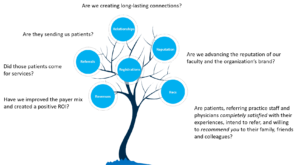
Consumerism in Healthcare: The Impact on Physician Relationship Management
Overview
Consumerism among referring physicians is yet another emerging trend. Referring physicians account for a substantial percentage of patient volume and decision-making influence. Yet, despite good intentions, lack of a holistic strategy and processes make it difficult for organizations to facilitate meaningful relationships with referring physicians.
Physicians are consumers too, and in many ways, their expectations align with those of patients. This means that, like patients, they expect an omnichannel experience that is personalized and efficient. Also like patients, it takes an exceptional experience to gain their loyalty and stand out in the increasingly cluttered healthcare landscape.
To build the infrastructure to meet these expectations, hospitals must change their mindset. In the consumer world of marketing it’s widely understood that sales, access/contact centers, and marketing must work together. This is also true when building relationships with referring physicians.
Consumerism demands that physician relationship management encompass a variety of activities and integrate stakeholders that impact to referring physicians.
Key activities include:
- Marketing generates awareness, creates demand and provides access to meaningful information. Fundamentally, marketing is the top of the sales pipeline, making it easier for liaisons to distribute the message and allowing physicians to engage with the organization. Examples include websites, email marketing, trade shows, and branded printed materials.
- Outreach refers to the direct relationship building activities done between individuals. A common misconception is that outreach activities are only done by liaisons – but effective outreach is cross-functional and includes medical staff. As with patient-consumers, physicians expect a personal experience in which medical staff periodically reach out to them to build rapport and increase confidence in making a referral.
- Operations refers to their experience during the continuum of their referral experience, from initial access to transition back to care of the referring physician. Like patient-consumers, they expect seamless communication across channels, and are not hesitant to switch their referrals if they have poor experiences. For example, difficulty securing an appointment with the right provider or not receiving an update after the patient’s referral is a source of frustration and commonly cited as a common pain point and reason to switch.
Creating a multifaceted Physician Relationship Management plan requires is worth the effort. If it seems overwhelming to get started, a first step is to understand your objectives and ensure that you have a solid understanding of the needs of your referring physicians. Then, you can use this background to restructure conversations with internal stakeholders to think about the “business” rather than the tactics.
Taking Action
Here are some tools and best practices that can help during the planning process:
- Don’t rely on assumptions. As a starting place for building the plan and gaining cross-functional support, it is necessary to get to the heart of what matters most to your referring physicians. Identification of their needs creates a compelling foundation for change and action planning. There are various research methods to do this, including experience mapping, which provides a holistic view of how to improve experiences and grow advocacy.
- Leadership must support active engagement of medical staff in building relationships with referrers. Reinforcing this cultural value starts early, by providing new physicians with onboarding and training to help them build professional relationships, what support is available through the physician relations team, and how to best use services provided by the hospital.
- A robust PRM (Physician Relationship Management) tool allows the team to embrace facts and data to manage and grow referrals. Referral source metrics can assess volume trends and changes, identify “lost” and “new” referrers, allow the team opportunities for service recovery and improving outreach efforts. Here, we provide tips to ensure your PRM creates value.
- Regularly assess and optimize the omni-channel referral experience. “Omni” simply means everything. Examining the referral experience holistically, across all touchpoints, is critical to ensuring that physicians have high quality, consistent experiences. Whether the channel is the portal, referral hotline, service line, or doc-to-doc, the channel should provide an efficient referral process.
- Account for emotional and functional needs. Remember; physicians are consumers too. Just as patients want to feel valued and remembered, physicians also need to feel included in the treatment and valued as fellow professionals. For example, even if most follow-up communication is automated, including a short personal note to summarize the next steps and thank the physician for their referral goes a long way.
- Tools such as benchmarking can help leadership determine current performance and prioritize future goals. As one option, Endeavor provides a complimentary benchmarking tool for physician relations. It takes about 10 minutes to complete and provides anchor points which indicate various levels of maturity.

John M. McKeever
Chief Growth Officer
John McKeever supports leaders who are seeking to make high impact changes in their business, primarily to advance strategies for growth and business optimization. He organizes and oversees teams who develop market insight, nurture high performance teams, deploy purpose driven communications,…
Let’s Talk
We will help you overcome strategic challenges to realize the business value you seek.

